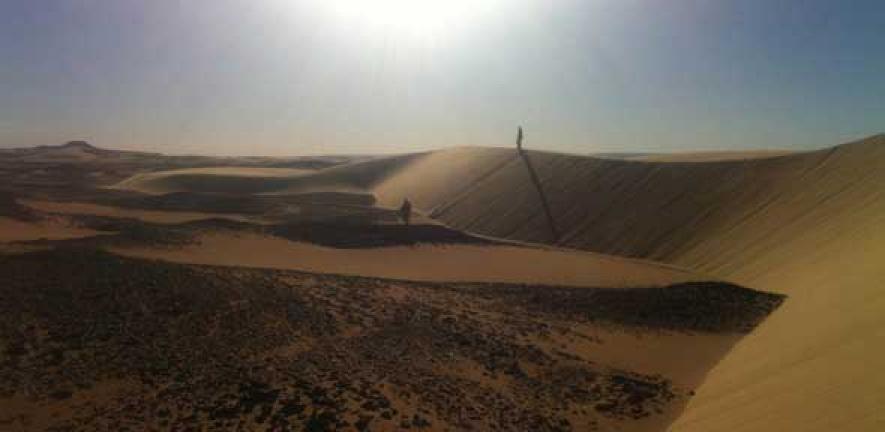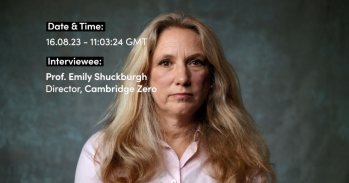
We are not the first to experience environmental change. Does the past have anything to teach us as we search for ways to adapt?
We are not the first to experience environmental change. Does the past have anything to teach us as we search for ways to adapt?
It’s clear from our work in Egypt that there was climate change going on all the time, and this affected different people in different ways
Judith Bunbury
Climate change today is considered different to climate change at any other time in Earth’s history because of its link to human activities. But large-scale changes in climate have occurred before, some gradual and some extremely rapid. Ancient civilisations experienced this, as we do, through changes in their physical environment, as Dr Judith Bunbury’s research in Egypt is revealing through her analysis of the pattern of changing landscapes. The results are providing clues to how populations adapted over the past 10,000 years.
“The wonderful thing about Egypt is that we have documentary evidence, we’ve got physical architectural remains, and we find lots of artefacts and the sediments that encapsulated them. So we can see not only the way the landscape changed, but the way people thought about it – we’re trying to read the dialogue between humans and their environment.” Drawing on her expertise in geology, Bunbury, a Geo-archaeologist in the Cambridge’s Department of Earth Sciences, works with archaeologists and historians to recreate a picture of the changing past.
Bunbury has just returned from a field season at the Kharga Oasis, an area of Egypt’s Western desert with archaeological sites dating from the prehistoric period to the 19th century AD. Study of the geology of the region is revealing that there were once expansive lakes with shores inhabited by prehistoric man. “We’ve found flint tools used for hunting, and drawings on the rocks of a rich fauna including tethered giraffes and an elephant,” said Bunbury. As global temperatures fell, the rains failed and the region became desert. Her work shows that the human communities moved away, and their technologies are later discovered in the Nile Valley, dated to around 3,100 BC.
“We’ve got historical texts from the last 5,000 years,” said Bunbury. “These people weren’t naive; I think their theology – basically the academia of the time – reflected their knowledge of the way the landscape changed,” she added. “At around 3,100 BC, the texts start identifying Seth – the god of the desert storm – as evil, rather than the protective force of earlier times. They talk about islands rising from the waters, which would have happened when lakes dried up. These people went through a kind of climate change crisis.”
“We see from the geology that the environment was changing for a long time, but according to the texts the people only started to panic at a particular point,” said Bunbury. “All the literature was focused on Memphis, the ancient capital of Egypt, but we now understand that drier conditions swept southwards through Egypt and didn’t happen everywhere at once. People didn’t always document things literally, so there’s great value in this interdisciplinary approach.”
Her work is revealing how gradual changes, such as the river Nile’s migration at a rate of around 2 km per millennium, or varying lake levels, forced some populations to keep moving their settlements. As a source of food and water, and – in the case of rivers – a transport route, adaptation to these natural changes was vital. “Some of the substantial ancient settlements in Egypt are still there, like those near the pyramids at Giza and around the temples of Luxor. The early buildings were constructed on an island, but the river moved away while the monuments were developing and we see evidence in building plans for adaptations to this, for example they put in brick segments to stabilise the new land for more buildings – basically land reclamation.” By the Roman Period, from 30 BC to 641 AD, underground waterways had been created in what is now the Sahara desert. Serviced by vertical wells along their route, these brought in water from every possible source to sustain communities and agricultural systems.
Close examination of sediment samples is a key aspect of Bunbury’s work. In a process called augering, she uses a device shaped like a large apple corer to take cores of sediment from up to 10 m below the surface, and sifts through them for artefacts such as pottery, beads and stone chips. At typical Egyptian sedimentation rates these cores can cut through 1,000 years. Not only do artefacts help to date the sediments, but they can also provide clues to the people living in the region. “Sediments can tell us how deep the water was and how fast it moved, or what an environment close to the water was like,” said Bunbury. “They can change a reconstruction of the landscape completely. It’s like doing a jigsaw,” she added. “You have all the pieces, but for the first time you’re actually starting to see the real picture – it’s very exciting.”
With the whole Nile valley and delta now buried under a blanket of sediment, deciding where to look had until recently involved a lot of guesswork and, as a result, a lot of sediment samples to work through. “Ten years ago we were using satellite images to add information to what we were already doing on the ground,” said Bunbury. “Now there’s so much information available from remote sensing that we can use it to go straight to the right sites. Whereas in the past we would have taken 50 sediment samples to find the useful information, now we only need two or three, so we can go through what we pull out in really fine detail.”
By piecing together the different environments in different periods, a distinct picture of a changing landscape is emerging. “It’s clear from our work in Egypt that there was climate change going on all the time, and this affected different people in different ways,” said Bunbury. “Resources weren’t stationary, so they had to keep adapting.”
She suggests that perhaps the hardships our distant ancestors wrestled with can teach us something about dealing with our climate problems today. “How do we compare to people who experienced changing climates in the past? Some wrote literature about how terrible it was, others just accepted it and moved, and others developed new technologies such as the Romans’ underground system to transport water for kilometres across the desert. It’s fiction to think climate change doesn’t happen – it’s just a question of how it happens, when, and how fast,” she said.
Even over the 20 years she has been studying sites in Egypt, Bunbury has noticed new changes. “By understanding what Egypt was like 6,000 and 4,000 years ago, we can understand what it might become like again as the climate starts to change back,” she said. “It’s already getting wetter again, and in the last few years aquifers are being filled, trees are starting to grow again, and the desert is greening. If we don’t record the past now, it will be destroyed forever.”
This work is licensed under a Creative Commons Licence. If you use this content on your site please link back to this page.





